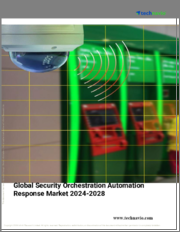
|
시장보고서
상품코드
1519462
세계의 보안 오케스트레이션 시장 보고서 : 유형별, 전개 형태별, 조직 규모별, 용도별, 최종 이용 산업별, 지역별(2024-2032년)Security Orchestration Market Report by Type, Deployment Mode, Organization Size, Application, End Use Industry, and Region 2024-2032 |
||||||
세계 보안 오케스트레이션 시장 규모는 2023년 32억 달러에 달했습니다. 앞으로 IMARC Group은 2024년부터 2032년까지 14.2%의 성장률(CAGR)을 보이며, 2032년에는 108억 달러에 달할 것으로 예측했습니다.
보안 오케스트레이션은 보안 운영 센터(SOC) 기술과 프로세스의 이종 생태계를 통합하고 효과적인 보안 운영을 위한 작업을 자동화하는 프로세스입니다. 이는 위협을 방지, 검색 및 복구하기 위한 여러 사이버 보안 도구로 구성됩니다. 다수의 소스에서 관련 데이터를 추출하고 수신된 경보를 향상시켜 보안 팀이 컨텍스트를 신속하게 적용할 수 있도록 합니다. 또한 사고 대응 팀은 경고의 방어, 분석, 보안 인시던트 조사 및 위협 인텔리전스를 촉진하여 전략적 의사 결정을 내릴 수 있습니다. 그 결과, 보안 오케스트레이션은 에너지·유틸리티, 정부 기관, 헬스케어, 소매, 정보·기술(IT), 통신, 은행 및 금융 서비스·보험(BFSI)의 각 분야에서 폭넓게 활용되고 있습니다.
보안 오케스트레이션 시장 동향 :
중소기업과 중소기업에서 BYOD(Bring Your Own Device)의 보급으로 다양한 업종의 조직에서 보안 침해가 증가하고 있습니다. 이것은 네트워크 인프라의 빈번한 변화와 함께 시장을 견인하는 중요한 요소 중 하나가되었습니다. 또한 비용 효율적인 클라우드 기반 보안 오케스트레이션을 세계에서 사용할 수 있게 되었기 때문에 시장 성장을 뒷받침하고 있습니다. 또한 통신 분야에서는 중요한 비즈니스 용도에 고급 보안을 제공하기 위해 보안 오케스트레이션의 사용이 증가하고 있습니다. 이 외에도 데이터센터 전반에 걸쳐 데이터 온 디맨드가 증가함에 따라 매우 중요한 기술 환경이 보안 오케스트레이션 수요를 자극하고 있습니다. 이 외에도 세계 각국의 정부가 네트워크 인프라와 연구개발 활동에 대한 투자를 적극적으로 추진하고 있는 것도 시장에 긍정적인 영향을 미치고 있습니다. 게다가 최첨단 보안 기술에 대한 수요가 세계적으로 증가하고 있는 것도 주요 시장 관계자들에게 유리한 성장 기회를 제공합니다. 게다가 다양한 기업의 보안 운영 부문을 높이기 위해 보안 오케스트레이션의 채택이 증가하고 있는 것도 시장 성장을 뒷받침하고 있습니다.
이 보고서에서 다루는 주요 질문
- 2023년 세계 보안 오케스트레이션 시장 규모는?
- 2024-2032년 세계 보안 오케스트레이션 시장의 예상 성장률은?
- 세계 보안 오케스트레이션 시장을 견인하는 주요 요인은?
- 세계 보안 오케스트레이션 시장에 대한 COVID-19의 영향은?
- 세계 보안 오케스트레이션 시장의 유형별 내역은?
- 세계 보안 오케스트레이션 시장의 전개 모드별 내역은?
- 세계 보안 오케스트레이션 시장의 조직 규모별 내역은?
- 세계 보안 오케스트레이션 시장의 최종 이용 산업별 내역은?
- 세계 보안 오케스트레이션 시장의 주요 지역은?
- 세계 보안 오케스트레이션 시장의 주요 기업은?
목차
제1장 서문
제2장 조사 범위와 조사 방법
- 조사의 목적
- 이해관계자
- 데이터 소스
- 1차 정보
- 2차 정보
- 시장 추정
- 상향식 접근
- 하향식 접근
- 조사 방법
제3장 주요 요약
제4장 소개
- 개요
- 주요 업계 동향
제5장 세계 보안 오케스트레이션 시장
- 시장 개요
- 시장 실적
- COVID-19의 영향
- 시장 예측
제6장 시장 분석 : 유형별
- 소프트웨어
- 시장 동향
- 시장 예측
- 서비스
- 시장 동향
- 시장 예측
제7장 시장 내역: 전개 형태별
- 클라우드 기반
- 시장 동향
- 시장 예측
- 온프레미스
- 시장 동향
- 시장 예측
제8장 시장 내역: 조직 규모별
- 중소기업
- 시장 동향
- 시장 예측
- 대기업
- 시장 동향
- 시장 예측
제9장 시장 분석 : 용도별
- 컴플라이언스 관리
- 시장 동향
- 시장 예측
- 위협 인텔리전스
- 시장 동향
- 시장 예측
- 티켓 솔루션
- 시장 동향
- 시장 예측
- 네트워크 포렌식
- 시장 동향
- 시장 예측
- 기타
- 시장 동향
- 시장 예측
제10장 시장 내역: 최종 이용 산업별
- BFSI
- 시장 동향
- 시장 예측
- IT 및 통신
- 시장 동향
- 시장 예측
- 정부 및 방위
- 시장 동향
- 시장 예측
- 전자상거래
- 시장 동향
- 시장 예측
- 기타
- 시장 동향
- 시장 예측
제11장 시장 분석: 지역별
- 북미
- 미국
- 캐나다
- 아시아태평양
- 중국
- 일본
- 인도
- 한국
- 호주
- 인도네시아
- 기타
- 유럽
- 독일
- 프랑스
- 영국
- 이탈리아
- 스페인
- 러시아
- 기타
- 라틴아메리카
- 브라질
- 멕시코
- 기타
- 중동 및 아프리카
- 시장 동향
- 시장 분석 : 국가별
- 시장 예측
제12장 SWOT 분석
- 개요
- 강점
- 약점
- 기회
- 위협
제13장 밸류체인 분석
제14장 Porter's Five Forces 분석
- 개요
- 구매자의 협상력
- 공급기업의 협상력
- 경쟁도
- 신규 진입업자의 위협
- 대체품의 위협
제15장 가격 분석
제16장 경쟁 구도
- 시장 구조
- 주요 기업
- 주요 기업 프로파일
- Acalvio Technologies Inc.
- Accenture plc
- Amazon Web Services Inc.(Amazon.com Inc.)
- Cisco Systems Inc.
- Cyberbit(Elbit Systems)
- Exabeam Inc.
- Forescout Technologies Inc.
- International Business Machines Corporation
- Optiv Security Inc.
- Palo Alto Networks Inc.
- Swimlane Inc.
- Tufin
The global security orchestration market size reached US$ 3.2 Billion in 2023. Looking forward, IMARC Group expects the market to reach US$ 10.8 Billion by 2032, exhibiting a growth rate (CAGR) of 14.2% during 2024-2032.
Security orchestration is a process of integrating a disparate ecosystem of security operation center (SOC) technologies and processes to automate tasks for effective security operations. It comprises several cybersecurity tools to prevent, detect, and remediate threats. It enables security teams to quickly apply context by drawing relevant data from numerous sources and enriching alerts received. It also helps incident response teams to facilitate alert triage, analytics, security incident investigation, and threat intelligence for more strategic decision-making. As a result, security orchestration finds extensive applications in energy and utilities, government, healthcare, retail, information and technology (IT), telecommunication, and banking, financial services, and insurance (BFSI) sectors.
Security Orchestration Market Trends:
Due to the growing traction of bring your own device (BYOD) in medium and small businesses, there is a rise in security breaches across organizations of different industry verticals. This, along with the frequent changes in network infrastructures, represents one of the key factors driving the market. Moreover, the availability of cost-efficient cloud-based security orchestration across the globe is propelling the growth of the market. In addition, there is an increase in the utilization of security orchestration in the telecommunication sector to offer advanced security for critical business applications. This, coupled with the highly crucial technological environment due to increasing data-on-demand generation across data centers, is catalyzing the demand for security orchestration. Besides this, governments of several countries are extensively investing in network infrastructures and research and development (R&D) activities around the world, which is positively influencing the market. Additionally, the growing demand for cutting-edge security technology worldwide is offering lucrative growth opportunities to key market players. Furthermore, the rising employment of security orchestration to boost the security operations threshold of different enterprises is bolstering the market growth.
Key Market Segmentation:
IMARC Group provides an analysis of the key trends in each sub-segment of the global security orchestration market report, along with forecasts at the global, regional and country level from 2024-2032. Our report has categorized the market based on type, deployment mode, organization size, application and end use industry.
Breakup by Type:
Software
Services
Breakup by Deployment Mode:
Cloud-based
On-premises
Breakup by Organization Size:
Small and Medium- sized Enterprises
Large Enterprises
Breakup by Application:
Compliance Management
Threat Intelligence
Ticketing Solutions
Network Forensics
Others
Breakup by End Use Industry:
BFSI
IT and Telecommunication
Government and Defense
E-Commerce
Others
Breakup by Region:
North America
United States
Canada
Asia-Pacific
China
Japan
India
South Korea
Australia
Indonesia
Others
Europe
Germany
France
United Kingdom
Italy
Spain
Russia
Others
Latin America
Brazil
Mexico
Others
Middle East and Africa
Competitive Landscape:
The competitive landscape of the industry has also been examined along with the profiles of the key players being Acalvio Technologies Inc., Accenture plc, Amazon Web Services Inc. (Amazon.com Inc.), Cisco Systems Inc., Cyberbit (Elbit Systems), Exabeam Inc., Forescout Technologies Inc., International Business Machines Corporation, Optiv Security Inc., Palo Alto Networks Inc., Swimlane Inc. and Tufin.
Key Questions Answered in This Report
- 1. What was the size of the global security orchestration market in 2023?
- 2. What is the expected growth rate of the global security orchestration market during 2024-2032?
- 3. What are the key factors driving the global security orchestration market?
- 4. What has been the impact of COVID-19 on the global security orchestration market?
- 5. What is the breakup of the global security orchestration market based on the type?
- 6. What is the breakup of the global security orchestration market based on the deployment mode?
- 7. What is the breakup of the global security orchestration market based on the organization size?
- 8. What is the breakup of the global security orchestration market based on the application?
- 9. What is the breakup of the global security orchestration market based on the end use industry?
- 10. What are the key regions in the global security orchestration market?
- 11. Who are the key players/companies in the global security orchestration market?
Table of Contents
1 Preface
2 Scope and Methodology
- 2.1 Objectives of the Study
- 2.2 Stakeholders
- 2.3 Data Sources
- 2.3.1 Primary Sources
- 2.3.2 Secondary Sources
- 2.4 Market Estimation
- 2.4.1 Bottom-Up Approach
- 2.4.2 Top-Down Approach
- 2.5 Forecasting Methodology
3 Executive Summary
4 Introduction
- 4.1 Overview
- 4.2 Key Industry Trends
5 Global Security Orchestration Market
- 5.1 Market Overview
- 5.2 Market Performance
- 5.3 Impact of COVID-19
- 5.4 Market Forecast
6 Market Breakup by Type
- 6.1 Software
- 6.1.1 Market Trends
- 6.1.2 Market Forecast
- 6.2 Services
- 6.2.1 Market Trends
- 6.2.2 Market Forecast
7 Market Breakup by Deployment Mode
- 7.1 Cloud-based
- 7.1.1 Market Trends
- 7.1.2 Market Forecast
- 7.2 On-premises
- 7.2.1 Market Trends
- 7.2.2 Market Forecast
8 Market Breakup by Organization Size
- 8.1 Small and Medium- sized Enterprises
- 8.1.1 Market Trends
- 8.1.2 Market Forecast
- 8.2 Large Enterprises
- 8.2.1 Market Trends
- 8.2.2 Market Forecast
9 Market Breakup by Application
- 9.1 Compliance Management
- 9.1.1 Market Trends
- 9.1.2 Market Forecast
- 9.2 Threat Intelligence
- 9.2.1 Market Trends
- 9.2.2 Market Forecast
- 9.3 Ticketing Solutions
- 9.3.1 Market Trends
- 9.3.2 Market Forecast
- 9.4 Network Forensics
- 9.4.1 Market Trends
- 9.4.2 Market Forecast
- 9.5 Others
- 9.5.1 Market Trends
- 9.5.2 Market Forecast
10 Market Breakup by End Use Industry
- 10.1 BFSI
- 10.1.1 Market Trends
- 10.1.2 Market Forecast
- 10.2 IT and Telecommunication
- 10.2.1 Market Trends
- 10.2.2 Market Forecast
- 10.3 Government and Defense
- 10.3.1 Market Trends
- 10.3.2 Market Forecast
- 10.4 E-Commerce
- 10.4.1 Market Trends
- 10.4.2 Market Forecast
- 10.5 Others
- 10.5.1 Market Trends
- 10.5.2 Market Forecast
11 Market Breakup by Region
- 11.1 North America
- 11.1.1 United States
- 11.1.1.1 Market Trends
- 11.1.1.2 Market Forecast
- 11.1.2 Canada
- 11.1.2.1 Market Trends
- 11.1.2.2 Market Forecast
- 11.1.1 United States
- 11.2 Asia-Pacific
- 11.2.1 China
- 11.2.1.1 Market Trends
- 11.2.1.2 Market Forecast
- 11.2.2 Japan
- 11.2.2.1 Market Trends
- 11.2.2.2 Market Forecast
- 11.2.3 India
- 11.2.3.1 Market Trends
- 11.2.3.2 Market Forecast
- 11.2.4 South Korea
- 11.2.4.1 Market Trends
- 11.2.4.2 Market Forecast
- 11.2.5 Australia
- 11.2.5.1 Market Trends
- 11.2.5.2 Market Forecast
- 11.2.6 Indonesia
- 11.2.6.1 Market Trends
- 11.2.6.2 Market Forecast
- 11.2.7 Others
- 11.2.7.1 Market Trends
- 11.2.7.2 Market Forecast
- 11.2.1 China
- 11.3 Europe
- 11.3.1 Germany
- 11.3.1.1 Market Trends
- 11.3.1.2 Market Forecast
- 11.3.2 France
- 11.3.2.1 Market Trends
- 11.3.2.2 Market Forecast
- 11.3.3 United Kingdom
- 11.3.3.1 Market Trends
- 11.3.3.2 Market Forecast
- 11.3.4 Italy
- 11.3.4.1 Market Trends
- 11.3.4.2 Market Forecast
- 11.3.5 Spain
- 11.3.5.1 Market Trends
- 11.3.5.2 Market Forecast
- 11.3.6 Russia
- 11.3.6.1 Market Trends
- 11.3.6.2 Market Forecast
- 11.3.7 Others
- 11.3.7.1 Market Trends
- 11.3.7.2 Market Forecast
- 11.3.1 Germany
- 11.4 Latin America
- 11.4.1 Brazil
- 11.4.1.1 Market Trends
- 11.4.1.2 Market Forecast
- 11.4.2 Mexico
- 11.4.2.1 Market Trends
- 11.4.2.2 Market Forecast
- 11.4.3 Others
- 11.4.3.1 Market Trends
- 11.4.3.2 Market Forecast
- 11.4.1 Brazil
- 11.5 Middle East and Africa
- 11.5.1 Market Trends
- 11.5.2 Market Breakup by Country
- 11.5.3 Market Forecast
12 SWOT Analysis
- 12.1 Overview
- 12.2 Strengths
- 12.3 Weaknesses
- 12.4 Opportunities
- 12.5 Threats
13 Value Chain Analysis
14 Porters Five Forces Analysis
- 14.1 Overview
- 14.2 Bargaining Power of Buyers
- 14.3 Bargaining Power of Suppliers
- 14.4 Degree of Competition
- 14.5 Threat of New Entrants
- 14.6 Threat of Substitutes
15 Price Analysis
16 Competitive Landscape
- 16.1 Market Structure
- 16.2 Key Players
- 16.3 Profiles of Key Players
- 16.3.1 Acalvio Technologies Inc.
- 16.3.1.1 Company Overview
- 16.3.1.2 Product Portfolio
- 16.3.2 Accenture plc
- 16.3.2.1 Company Overview
- 16.3.2.2 Product Portfolio
- 16.3.2.3 Financials
- 16.3.2.4 SWOT Analysis
- 16.3.3 Amazon Web Services Inc. (Amazon.com Inc.)
- 16.3.3.1 Company Overview
- 16.3.3.2 Product Portfolio
- 16.3.3.3 SWOT Analysis
- 16.3.4 Cisco Systems Inc.
- 16.3.4.1 Company Overview
- 16.3.4.2 Product Portfolio
- 16.3.4.3 Financials
- 16.3.4.4 SWOT Analysis
- 16.3.5 Cyberbit (Elbit Systems)
- 16.3.5.1 Company Overview
- 16.3.5.2 Product Portfolio
- 16.3.6 Exabeam Inc.
- 16.3.6.1 Company Overview
- 16.3.6.2 Product Portfolio
- 16.3.7 Forescout Technologies Inc.
- 16.3.7.1 Company Overview
- 16.3.7.2 Product Portfolio
- 16.3.8 International Business Machines Corporation
- 16.3.8.1 Company Overview
- 16.3.8.2 Product Portfolio
- 16.3.8.3 Financials
- 16.3.8.4 SWOT Analysis
- 16.3.9 Optiv Security Inc.
- 16.3.9.1 Company Overview
- 16.3.9.2 Product Portfolio
- 16.3.10 Palo Alto Networks Inc.
- 16.3.10.1 Company Overview
- 16.3.10.2 Product Portfolio
- 16.3.10.3 Financials
- 16.3.10.4 SWOT Analysis
- 16.3.11 Swimlane Inc.
- 16.3.11.1 Company Overview
- 16.3.11.2 Product Portfolio
- 16.3.12 Tufin
- 16.3.12.1 Company Overview
- 16.3.12.2 Product Portfolio
- 16.3.12.3 Financials
- 16.3.1 Acalvio Technologies Inc.


















